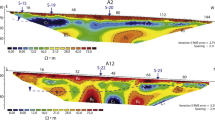Abstract
This article compares the efficiency of induced polarization (IP) and resistivity in characterizing a contamination plume due to landfill leakage in a typical tropical environment. The resistivity survey revealed denser electrical current flow that induced lower resistivity values due to the high ionic content. The increased ionic concentration diminished the distance of the ionic charges close to the membrane, causing a decrease in the IP phenomena. In addition, the self-potential (SP) method was used to characterize the preferential flow direction of the area. The SP method proved to be effective at determining the flow direction; it is also fast and economical. In this study, the resistivity results were better correlated with the presence of contamination (lower resistivity) than the IP (lower chargeability) data.












Similar content being viewed by others
References
Archie GE (1942) The electrical resistivity log as an aid in determining some reservoir characteristics. Trans AIME 146:54–64
Bertin J, Loeb J (1976) Experimental and theoretical aspects of induced polarization. Gebruder Borntraeger, v.1. Geopublication Associates, Berlin-Stuttgart, p 250
Cole KS, Cole RH (1941) Dispersion and absorption in dielectrics. 1 Alternating current fields. J Chem Phys 9:341
deGroot-Hedlin C, Constable S (1990) Occam’s inversion to generate smooth, two-dimensional models form magnetotelluric data. Geophysics 55(12):1613–1624
Edwards LS (1977) A modified pseudosection for resistivity and induced-polarization. Geophysics 42(5):1020–1036
Elis VR (1999) Avaliação da aplicabilidade de métodos elétricos de prospecção geofísica no estudo de áreas utilizadas para disposição de resíduos. Tese de Doutorado, Instituto de Geociências e Ciências Exatas, Universidade Estadual Paulista, Rio Claro, p 264
Gallas JDF (2000) Principais métodos geoelétricos e suas aplicações em prospecção mineral, hidrogeologia, geologia de engenharia e geologia ambiental. Tese de Doutorado, Instituto de Geociências e Ciências Exatas, Universidade Estadual Paulista, Rio Claro, p 174
Gallas JDF, Malagutti Filho W (2001) O método do potencial espontâneo (SP) na detecção de infiltrações em barragens. In: Anais (CD-ROM) Congresso Internacional da Sociedade Brasileira de Geofísica, Salvador
Gallas JDF, Malagutti Filho W, Prado RL, Taioli F (2003) Lixão do Alvarenga—Mapeamento da pluma de contaminação pelos métodos geoelétricos. In: Anais CD-ROM Congresso Internacional da Sociedade Brasileira de Geofísica, Rio de Janeiro
Godio A, Naldi M (2003) Two-dimensional electrical imaging for detection of hydrocarbon contaminants. Eur Assoc Geosci Eng Near Surf Geophys 1:131–137
Grahame SA (1947) The electrical double layer and the theory of electrocapillarity. Chem Rev 41:441–501
Hallof PG (1957) On the interpretation of resistivity and induced polarization measurements. PhD Thesis, MIT
Keller GV, Frischknecht FC (1977) Electrical methods in geophysical prospecting. Pergamon Press, Oxford, p 517
Klein JD, Shuey RT (1978a) Nonlinear impedance of mineral-electrolyte interface: Part I. Pyrite. Geophysics 43(6):1222–1234
Klein JD, Shuey RT (1978b) Nonlinear impedance of mineral-electrolyte interface: Part II. Galena, chalcopyrite, and graphite. Geophysics 43(6):1235–1249
Loke MH, Barker RD (1996a) Rapid least-squares inversion of apparent resistivity pseudosections by a quasi-Newton method. Geophys Prospect 44(1):131–152
Loke MH, Barker RD (1996b) Practical techniques for 3D resistivity surveys and data inversion. Geophys Prospect 44(3):499–523
Nascimento CTC, Koide S, Pires ACB, Mello GA (1999) Pseudo-seções elétricas na avaliação da contaminação do subsolo. Revista Brasileira de Geociências 29(4):621–626
Ogilvy R, Meldrum P, Chambers J, Williams G (2002) The use of 3D electrical resistivity tomography to characterize waste and leachate distribution within a closed landfill, Thriplow, UK. J Environ Eng Geophys 7(1):11–18
Orellana E (1972) Prospeccion geoeletrica en corriente continua. Paraninfo, Madrid, p 523
RES2DINV ver. 3.54 (2004) Rapid 2-D resistivity and IP inversion using the least-squares method. Geoelectric Imaging 2-D and 3D. Geotomo Software, Malaysia
Roy KK, Elliot HM (1980) Model studies on some aspects of resistivity and membrane polarization behavior over a layered earth. Geophys Prospect 28(5):759–775
Seaton WJ, Burbey TJ (2002) Evaluation of two-dimensional resistivity methods in a fractured crystalline–rock terrane. J Appl Geophys 51:21–41
Silva JTC (2003) Métodos geoelétricos em apoio ao mapeamento de contaminação por esgotos domésticos em Salesópolis, SP. Trabalho de formatura, Instituto de Geociências, Universidade de São Paulo, São Paulo, p 39
Soupios P, Papadopoulos N, Papadopoulos I, Valianatos F, Sarris A, Manios T (2007) Application of integrated methods in mapping waste disposal areas. Environ Geol 53(1):661–675
Sumner JS (1976) Principles of induced polarization for geophysical exploration. Elsevier Scientific Publishing Co, New York, p 277
Telford WM, Geldart LP, Sheriff RE (1990) Applied geophysics, 2nd edn. Cambridge University Press, Cambridge, p 770
Varnier C, Hirata R (2002) Contaminação da água subterrânea por nitrato no Parque Ecológico do Tietê–São Paulo, Brasil. Revista Águas Subterrâneas 16:77–82
Vega de la M, Osella A, Lascano E (2003) Joint inversion of Wenner and dipole–dipole data to study a gasoline-contaminated soil. J Appl Geophys 54:97–109
Ward SH (1990) Resistivity and induced polarization methods. Geotechnical and Environmental Geophysics. Society of Exploration Geophysicists, v.1: Review and Tutorial, pp 147–189
Author information
Authors and Affiliations
Corresponding author
Rights and permissions
About this article
Cite this article
Gallas, J.D.F., Taioli, F. & Malagutti Filho, W. Induced polarization, resistivity, and self-potential: a case history of contamination evaluation due to landfill leakage. Environ Earth Sci 63, 251–261 (2011). https://doi.org/10.1007/s12665-010-0696-y
Received:
Accepted:
Published:
Issue Date:
DOI: https://doi.org/10.1007/s12665-010-0696-y




